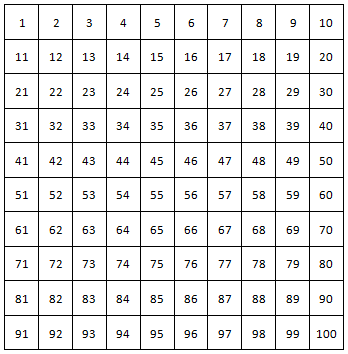Patterns and place value in counting
Our number system enables us to represent number using just ten digits (0, 1, 2, 3, 4, 5, 6, 7, 8, 9). Thus if we write out the first 100 digits in a hundred square (see below), we can see that there are ten squares in each row. The hundred square highlights the patterns in counting up to 100.
For example, there is a recurring sequence in the last digits; all numbers in the first column end with a 1, all those in the second column end with a 2, and so on until the tenth column which end with a 0. Similarly there is a pattern with the rows after the first row; all numbers in the second row start with a 1 until the last number which moves onto the next number. After 20 this pattern becomes more noticeable when expressed out loud.
For example, for row three the numbers are twenty-something until the final digit. This kind of pattern recognition is essential for moving on to counting numbers above 20. Before 20, learning the number names in English can be quite difficult, especially between 11 and 19 where unfortunately we do not say ‘onety-one, onety-two, etc.’

Once the pattern in counting is established up to a hundred, children can learn the principle of place value and realise that numbers can go on forever. In the decimal number system, the value that each digit represents is determined by its place in the number. Although a number is often verbally stated as if reading from left-to-right, place value is easier to determine from right-to-left. Thus the first digit on the right always represents the ‘ones’ or units, the second digit the tens, the third the hundreds and so on each time increasing the power by ten. An understanding of the place value of a digit allows the child to know that the 7 in 700 is ten times greater than the 7 in 70.
Furthermore an understanding of place value allows a user to transfer between the different codes used to represent number. For example, if you hear the words ‘one hundred one’, you should be able to represent this with numerals as ‘101’. Most children make errors when they are first asked to transcode between verbal labels for numbers and numerals; they may write ‘one hundred and one’ and ‘1001’, where the 100 is written first and the one added on the end. Transcoding skill improves with experience of the place value system but difficulties may be evident in those with mathematical difficulties.
Expected curriculum attainment
Counting and place value are expected learning outcomes in the new US curriculum. For example, by the end of Kindergarten, children are expected to be able to count to 100 both by ones and by tens. Furthermore some of principles of counting are explicitly outlined; children should know one-to-one correspondence, and that the last number counted represents the number in the set (cardinality principle). By the end of Grade 1, there should be an understanding of place value. In particular, children should understand that the two digits of a two-digit number represent amounts of tens and one. This extends to the hundreds by the end of Grade 2. An explicit knowledge of patterns has not been included as part of the standards for Common Core Standards Initiative, however patterns may be included as part of the teaching of mathematics to develop an understanding of place value.
Mathematical Difficulties and Counting
Most children show an understanding of counting by the end of the first year of formal education. However research has shown that despite using correct counting, some children with mathematical difficulties tend to understand counting as rote, mechanical activity and as such they may lack some of the basic principles of counting. For example, the knowledge that items can be counted in any order (the order-irrelevance principle) and always want to count items from left to right. Furthermore as counting is used as the primary strategy when starting to learn about simple arithmetic, difficulties with counting can lead to errors when calculating sums. MD children may also rely on finger counting for much longer which despite the involvement of sensory information is generally considered to be much more inefficient and thus make the transition to memory retrieval more difficult.









